Enjoy the Best Rabbit Hot Pot Recipe for Beginners - Lẩu thỏ
Rabbit hot pot, a savory and culturally rich dish, has been adored across multiple cultures and locales for centuries.This comprehensive guide explores the whole thing you need to learn about rabbit hot pot, from its culinary heritage to present-day styles, nutritional benefits, and easy-to-follow steps for creating the top-tier meal at home. Whether you are a experienced cook or a amateur chef, this guide will support and train you to master the art of rabbit hot pot.

UNVEILING THE STORY AS WELL AS CULTURE RELATED TO BRAISED RABBIT DISH.
Rabbit hot pot acts as a distinctive and traditional dish with profound heritage in multiple countries. Its appeal stems not only from its delicious flavor but also from its legacy and traditions.
1. Exploring the Evolution regarding Rabbit stew.
- Historical Beginnings: Rabbit hot pot was first made in farming communities where rabbits were a popular, wholesome food source. In ancient China, it was a beloved dish, particularly during festive times.
- Expansion Across Areas: In the West like France, rabbit was often included in broths, changing into modern versions of global stews as the dish became internationally recognized.
2. Braised Bunny Dish throughout Eastern Heritage.
- Throughout China: Known as China’s beloved rabbit hot pot, rabbit hot pot is celebrated in the Sichuan region, renowned for its pungent flavors and loved during reunion dinners.
- Within Korea and Japan: While not as popular, rabbit hot pot is rarely created as a nutritional hot pot in the Korean Peninsula, or drawing influence from Japan’s nabemono-style cooking in Japanese cuisine, including local garden vegetables and flavoring ingredients.
- Across Vietnam: Although rabbit hot pot is not a regular meal, it is popular during noteworthy gatherings or in rural areas where rabbit meat is abundant. It is often made using distinctive spices such as citronella, fresh ginger, and red chili, paired with fresh vegetables like water spinach, mustard leaves, or aquatic greens. This dish is favored for its exceptional taste and high nutritional value, frequently eaten at family and friend reunions.
Tại Việt Nam, tuy không phổ biến là món ăn phổ thông liên tục mỗi ngày, nhưng nổi bật trong những sự kiện quan trọng hoặc ở các vùng xa xôi, nơi thịt thỏ rất sẵn có. Thường được tẩm ướp với các loại gia vị như sả, gừng, và ớt đỏ, kết hợp với rau muống. Món ăn này được lòng nhiều người nhờ vị ngon độc nhất và độ lành mạnh cao, thường là món ăn chính trong.
3. Traditional Rabbit Cuisine within Western Food Culture.
- Throughout France: Typically cooked as a rich stew with wine-infused broth, aromatic herbs including rosemary, and root vegetables. Rabbit hot pot is a beloved meal for festive feasts.
- In Italy: The dish referred to as “Cacciatore”, featuring rabbit braised in tomatoes and wine, is a foundation for rabbit hot pot dishes.
HOW TO COOK RABBIT HOT POT: RECIPES AND TECHNIQUES
Rabbit hot pot is a adaptable dish that merges natural components, savory broths, and distinct techniques to create a hearty and flavorful experience. Below are detailed insights into the key recipes and strategies to master rabbit hot pot.
Essential Recipe for Rabbit Hot Pot
* Ingredients:
- 1 whole rabbit (cut into pieces)
- 4 cups of broth (chicken)
- Vegetables (potatoes)
- Spices and herbs (star anise)
- Seasonings (salt)
- Optional: rice for serving
* Steps:
- Getting the Rabbit Ready: Rinse and cut the rabbit into pieces. Season with salt, pepper, and a splash of soy sauce for half an hour to boost the flavor.
- Prepare the Broth: Heat a pan with chế biến lẩu thỏ a bit of oil. Sauté garlic and sliced ginger until aromatic. Add your selected stock and bring it to a simmer.
- Add the Rabbit: Add the rabbit pieces into the pot and let them gently boil on low heat for 30-40 minutes until tender.
- Incorporate Vegetables: Add your chosen vegetables and cook until they are tender but still fresh-looking.
- Serve: Transfer the hot pot to a serving dish. Serve with side dishes and add-ons such as rice or noodles.
Key Techniques for Cooking Rabbit Hot Pot
- Flavor Enhancement:
. Marinate the rabbit with a mixture of salt, pepper, and aromatics to amplify its original taste.
. For more complexity, use wine, soy sauce, or a mix of fresh herbs like rosemary and thyme.
- Layering Ingredients:
. Start by boiling the rabbit in the broth to extract its savory taste.
. Layer vegetables strategically based on their required time.
- Optimal Cooking Duration:
. Avoid cooking too long the rabbit, as it can turn chewy.
. Test for completion by checking if the meat is fork-tender.
- Broth Adjustments:
. Fine-tune the broth by adding extra herbs as needed.
. Experiment with different broth bases, such as spicy Sichuan-style variations.
Tips for Success
- Fresh Ingredients: Always choose high-quality rabbit and farm-fresh produce for the best results.
- Achieve Harmony: Be attentive of the saltiness in the broth. Taste and adjust frequently during cooking.
- Sauce Pairings: Offer a variety of sauces like garlic-chili oil or soy-based dips to elevate the dining experience.
- Presentation: Use a portable stove or serve the hot pot as a focal point to encourage communal dining.
By mastering these methods and recipes, you can make a rabbit hot pot that’s both flavorful and visually appealing, turning it into a star attraction for any meal or gathering.